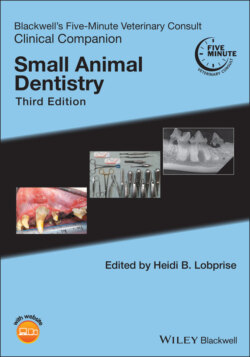Читать книгу Blackwell's Five-Minute Veterinary Consult Clinical Companion - Группа авторов - Страница 21
Shadow Technique (Modified “Bisecting Angle” Technique)
ОглавлениеIn all other teeth, the sensor/film cannot be placed parallel to the teeth; there will be some space between the tooth/root and film.
Position film as close to the tooth/root to be imaged as possible: you need to evaluate the roots, not the crown.Figure 3.4 Three tools to help with taking radiographs: spiral perm roller for keeping sensor/film in place; two tongue depressors attached with a push‐pin; and roll of tape.Figure 3.5 Intraoral films should be placed such that the image of the roots, not the crown, will be seen on the film; this film was placed against the palate to image the roots of the upper fourth premolar.Figure 3.6 Parallel placement of an intraoral film to image the mandibular premolars and molars, as demonstrated on this cat skull. Note the corner is pushed into the intermandibular space.
If the beam was aimed perpendicular to the film (Figure 3.7):This would result in a “shadow” or image of the tooth on the film that would be too short (think of a tree at noon).Therefore, perpendicular to film: too short (of an image).
If the beam was aimed perpendicular to tooth root(s) (Figure 3.8):This would result in a “shadow” or image of the tooth on the film that would be too long (think of a tree at daybreak).Therefore, perpendicular to tooth: too long (of an image).
Split the difference: come halfway between the two positions (Figure 3.9):The resulting “shadow” or image will be a compromise between the foreshortened and elongated images, with the image the approximate length of the tooth itself.In some of the images, a positioning device was made of two tongue depressors. The blue portion is aimed perpendicular to the film, and the red portion is aimed perpendicular to the tooth root. The X‐ray beam/source is then positioned midway between the two.Figure 3.7 When imaging these maxillary incisors and canines, if the beam were aimed perpendicular to the film, the images would be foreshortened.Figure 3.8 If the beam were aimed perpendicular to the teeth (roots), the images would be elongated.The positioning tool made of regular tongue depressors (see Figure 3.4) has the terms “Perpendicular to film – too short” and “Perpendicular to tooth – too long” printed on them to help determine the proper angles.
Other teeth:Mandibular incisors/caninesPerpendicular to film (Figure 3.10): too short.Perpendicular to teeth (Figure 3.11): too long.Split the difference (Figure 3.12).Maxillary upper fourth premolar in dogPerpendicular to film (Figure 3.13): too short.Perpendicular to teeth (Figure 3.14): too long.Split the difference (Figure 3.15).Figure 3.9 By “splitting the difference” between the two positions, the images will be closer to the actual size of the structures, minimizing distortion. The radiographic aid is placed with the green stick perpendicular to the film and the red stick perpendicular to the tooth (root). The beam is aimed midway between the two sticks.Figure 3.10 Mandibular incisors/canines: beam perpendicular to film.Figure 3.11 Mandibular incisors/canines: beam perpendicular to teeth (roots).Figure 3.12 Mandibular incisors/canines: split the difference.Figure 3.13 Maxillary premolars/molars: perpendicular to film.Figure 3.14 Maxillary premolars/molars: perpendicular to teeth (roots).Maxillary incisors/canines in catPerpendicular to film (blue positioning guide).Perpendicular to teeth (red positioning guide).Split the difference (Figure 3.16).
When positioning the beam, make sure it is aimed directly over the tooth (maxillary fourth premolar) or at midline (mandibular or maxillary incisors and canines for symmetry) (Figure 3.17). Adjust beam (laterally or obliquely for canines or mesially or distally for premolars) to “move” the superimposed apices away from each other (Figure 3.18).
Hint. Maxillary incisors and canines: on most dogs and cats (not brachycephalic breeds), aim the beam perpendicular to the ventral aspect of the nasal fold (or haired portion of muzzle just under the nares); in most cases, the positioning will closely approximate the correct beam alignment (Figure 3.19). Position the beam initially based on the nares, and confirm the angle.
Figure 3.15 Maxillary premolars/molars: split the difference.
Figure 3.16 Maxillary incisors/canines in cat: positioning aids illustrating perpendicular to the film (blue) and perpendicular to the teeth roots (red); split the difference with the beam.
Figure 3.17 Maxillary canines in dog: beam aimed initially at midline; roots of canines will be superimposed over premolar roots.
Figure 3.18 Maxillary canines in dog: adjust beam away from midline to separate image of canine apex from premolars.
Figure 3.19 In most dogs (not brachycephalic) and even some cats, by aiming the beam perpendicular to the ventral aspect of the nasal fold, the positioning will be adequate (approximates the split the difference position).
